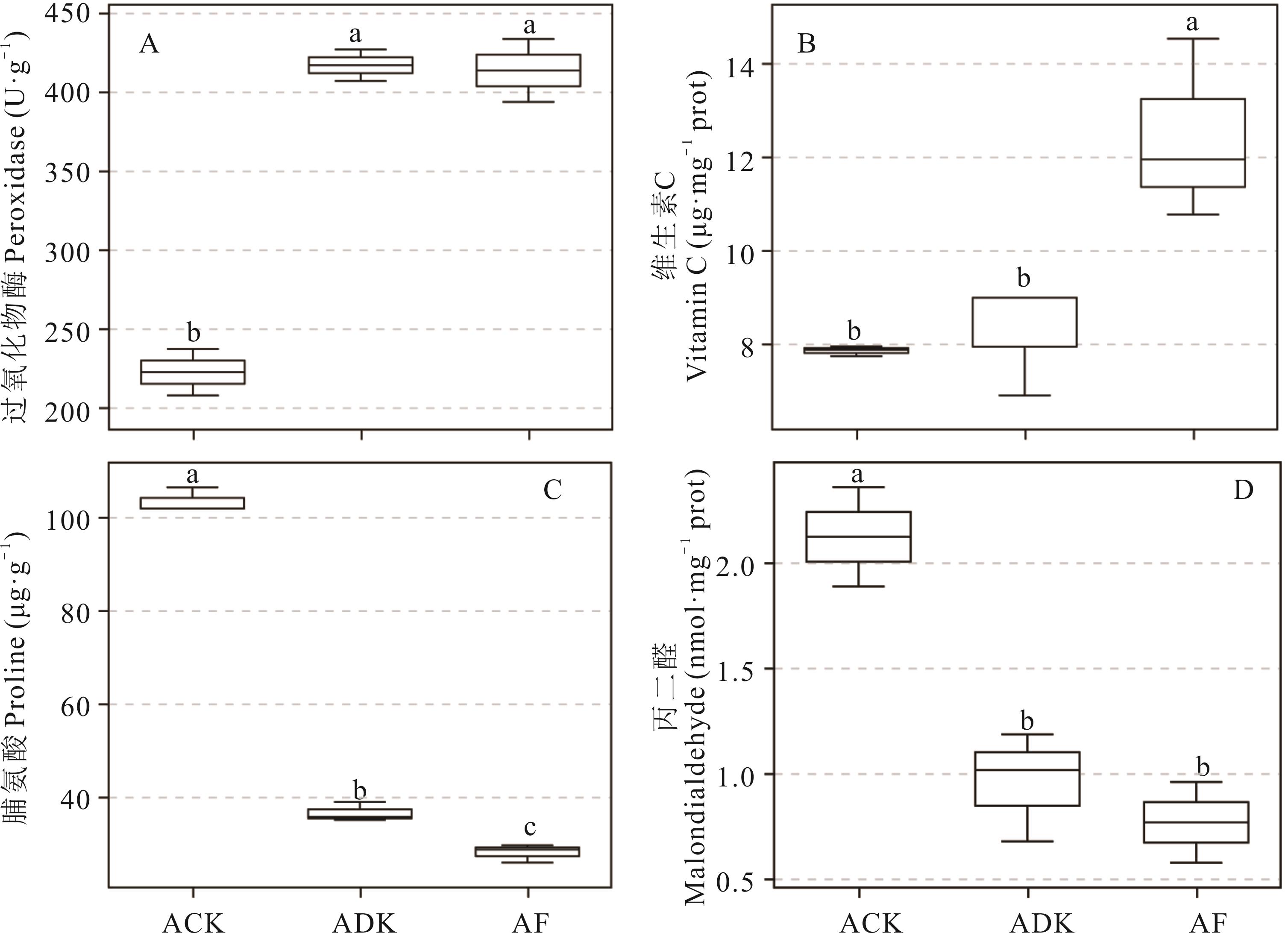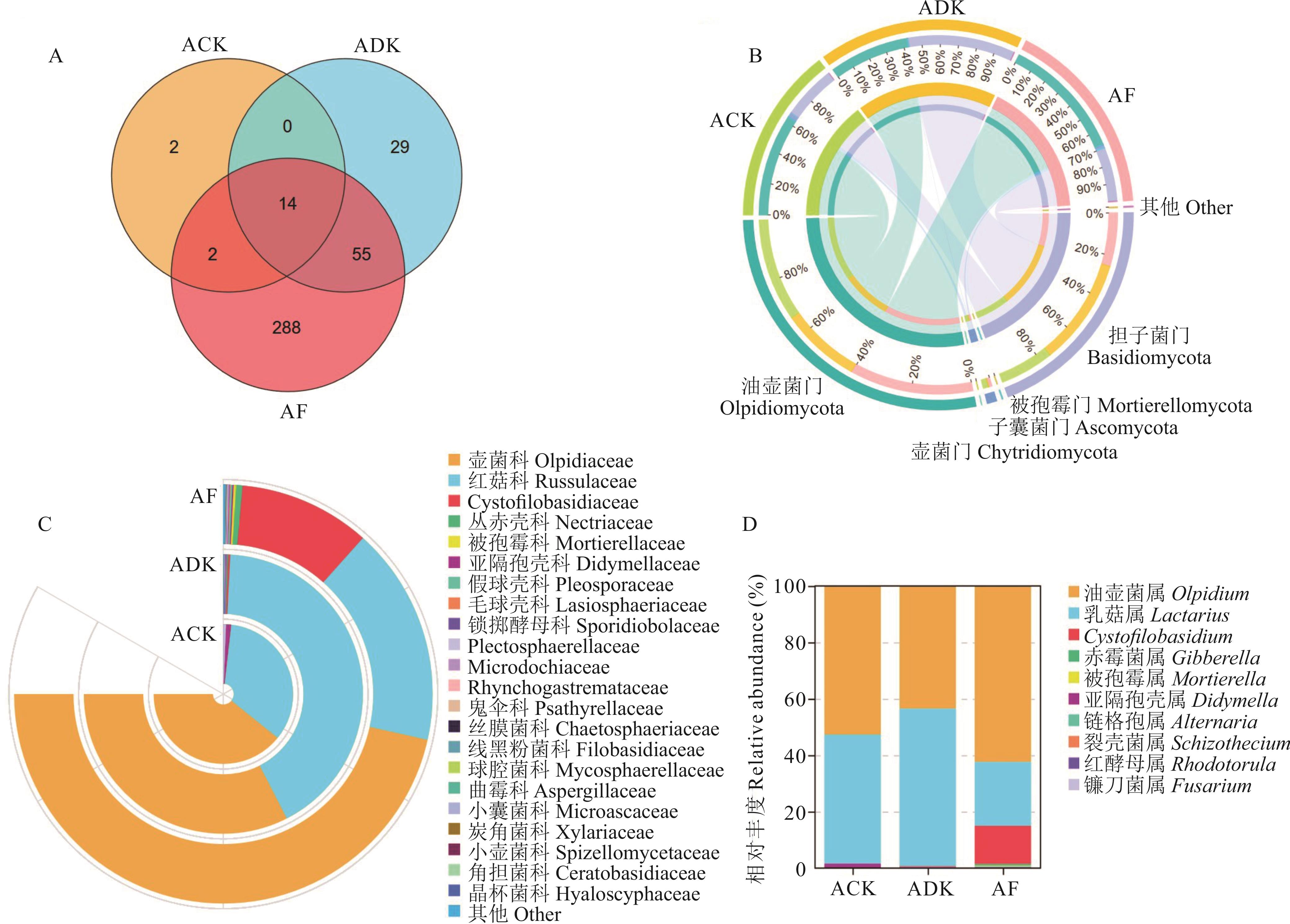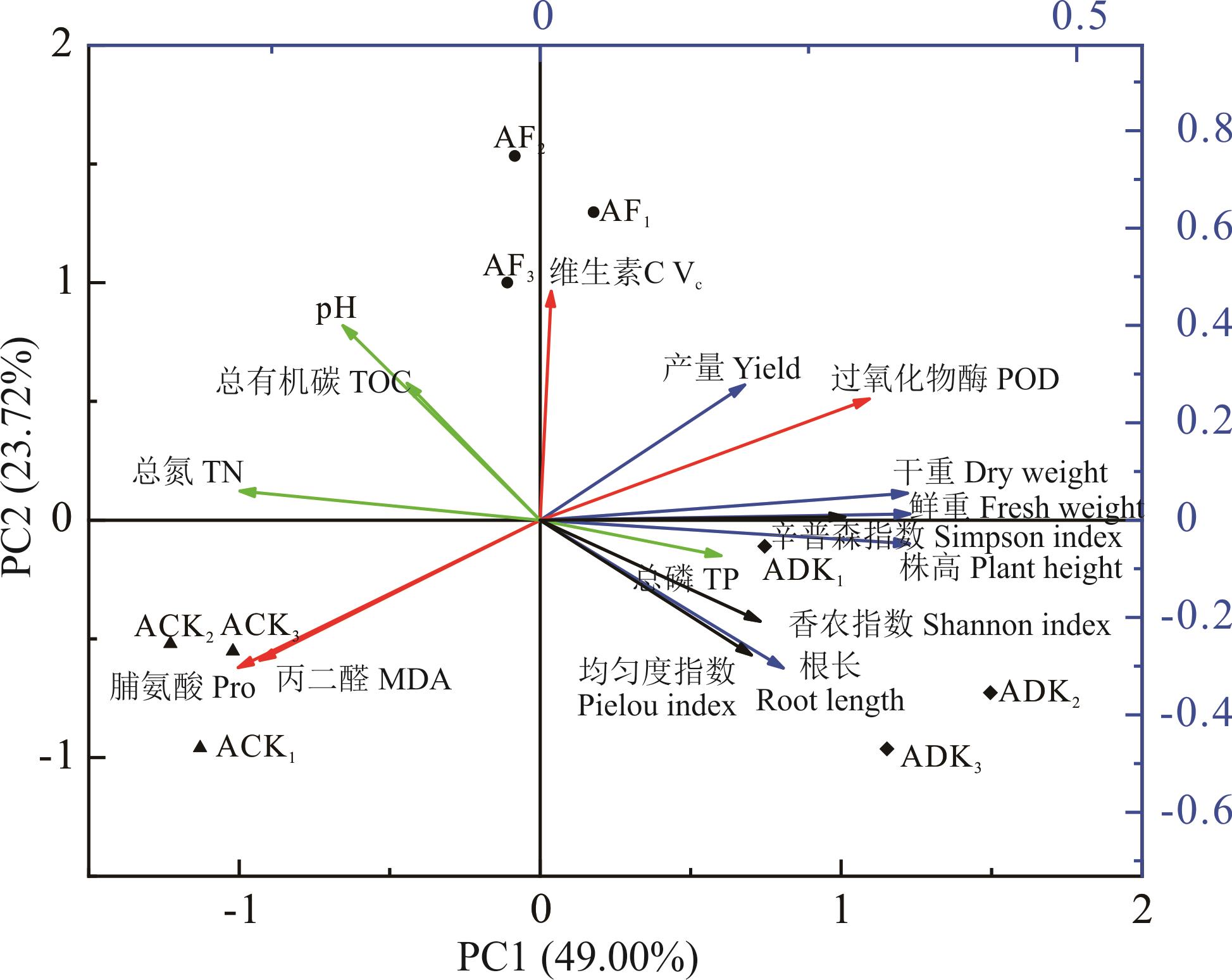

ISSN 1004-5759 CN 62-1105/S


草业学报 ›› 2025, Vol. 34 ›› Issue (1): 151-160.DOI: 10.11686/cyxb2024090
• 研究论文 • 上一篇
收稿日期:2024-03-20
修回日期:2024-04-17
出版日期:2025-01-20
发布日期:2024-11-04
通讯作者:
郭璟
作者简介:郭璟(1994-),女,青海乐都人,博士。E-mail: guojing2146@163.com基金资助:
Jing GUO1,2( ), Yue WANG1,2, Cun-ying QI1,2, Jing LI1,2
), Yue WANG1,2, Cun-ying QI1,2, Jing LI1,2
Received:2024-03-20
Revised:2024-04-17
Online:2025-01-20
Published:2024-11-04
Contact:
Jing GUO
摘要:
内生真菌在促进植物生长、增强抗逆性、改变植物根部微生物群落结构等方面有着重大的研究和开发价值。本研究采用内生真菌(木霉菌ADK和黄绿卷毛菇AF)浸种燕麦的方法开展田间试验,通过测定燕麦生长指标、生理生化指标、根际土壤理化指标,评价内生真菌浸种对燕麦的促生效果,并利用高通量测序技术研究内生真菌浸种对燕麦根部内生真菌群落组成的影响。结果表明:2种内生真菌均能促进燕麦株高生长,增加根长、干重、鲜重等,其中,ADK对燕麦生长性状影响最显著(P<0.05),AF对燕麦产量增加最显著(P<0.05)。内生真菌对燕麦生理也有显著影响(P<0.05),ADK和AF组过氧化物酶(POD)活性和维生素C(Vc)含量较CK分别增加87.53、86.03%%和5.56%、58.11%,脯氨酸(Pro)和丙二醛(MDA)含量分别减少64.62%、72.85%和54.82%、63.85%。此外,ADK和AF能够提高土壤全磷含量,且AF显著(P<0.05)提高土壤有机碳含量。Illumina高通量测序结果表明内生真菌浸种增加了燕麦根部内生真菌的Shannon指数、Pielou指数以及特有OTU的数量,改变了燕麦根部内生真菌群落结构。主成分分析(PCA)结果显示ADK促进了燕麦生长,增加了燕麦根部内生真菌多样性;AF提高了燕麦产量,增强了燕麦抗逆性。本研究揭示出内生真菌浸种对燕麦有显著的促生效果,并能增强燕麦的抗逆性及改变燕麦根部内生真菌群落结构,为后期开发植物促生菌剂提供了菌种资源,也有助于开发木霉菌及黄绿卷毛菇在生物菌肥方面的潜能。
郭璟, 王越, 祁存英, 李静. 内生真菌浸种对燕麦生长和根部内生真菌群落的影响[J]. 草业学报, 2025, 34(1): 151-160.
Jing GUO, Yue WANG, Cun-ying QI, Jing LI. Effects of endophytic fungi seed soaking on growth and root endophytic fungal communities of Avena sativa[J]. Acta Prataculturae Sinica, 2025, 34(1): 151-160.
处理 Treatment | 株高 Plant height (cm) | 根长 Root length (cm) | 鲜重 Fresh weight (g·plant-1) | 干重 Dry weight (g·plant-1) | 产量 Yield (kg·30 m-2) |
|---|---|---|---|---|---|
| ACK | 61.90±7.52c | 11.90±0.96b | 10.94±1.75c | 3.11±0.39c | 50.30±1.13b |
| ADK | 89.15±4.06a | 13.75±2.46a | 23.96±1.77a | 7.28±0.66a | 56.40±2.83a |
| AF | 72.13±1.64b | 12.28±0.95ab | 17.15±3.47b | 5.40±1.20b | 60.20±3.53a |
表1 内生真菌浸种对燕麦株高、根长、鲜重、干重和产量的影响
Table 1 Effect of endophytic fungi soaking on plant height, root length, fresh weight, dry weight, and yield of A. sativa
处理 Treatment | 株高 Plant height (cm) | 根长 Root length (cm) | 鲜重 Fresh weight (g·plant-1) | 干重 Dry weight (g·plant-1) | 产量 Yield (kg·30 m-2) |
|---|---|---|---|---|---|
| ACK | 61.90±7.52c | 11.90±0.96b | 10.94±1.75c | 3.11±0.39c | 50.30±1.13b |
| ADK | 89.15±4.06a | 13.75±2.46a | 23.96±1.77a | 7.28±0.66a | 56.40±2.83a |
| AF | 72.13±1.64b | 12.28±0.95ab | 17.15±3.47b | 5.40±1.20b | 60.20±3.53a |

图1 内生真菌浸种对燕麦生理生化指标的影响不同小写字母表示处理间差异显著(P<0.05)。Different lowercase letters indicate significant differences among different treatments (P<0.05).
Fig.1 Effects of endophytic fungi soaking on physiological and biochemical indexes of A. sativa
处理 Treatment | pH | 全氮 Total nitrogen (TN, g·kg-1) | 全磷 Total phosphorus (TP, g·kg-1) | 总有机碳 Total organic carbon (TOC, g·kg-1) |
|---|---|---|---|---|
| ACK | 7.92±0.04ab | 0.49±0.09a | 1.29±0.08b | 3.35±0.90b |
| ADK | 7.68±0.22b | 0.33±0.04b | 1.52±0.56a | 2.69±0.33c |
| AF | 8.10±0.02a | 0.41±0.02ab | 1.34±0.02b | 3.88±0.45a |
表2 内生真菌浸种对燕麦土壤理化性质的影响
Table 2 The influence of endophytic fungi soaking on soil physical and chemical properties of A. sativa
处理 Treatment | pH | 全氮 Total nitrogen (TN, g·kg-1) | 全磷 Total phosphorus (TP, g·kg-1) | 总有机碳 Total organic carbon (TOC, g·kg-1) |
|---|---|---|---|---|
| ACK | 7.92±0.04ab | 0.49±0.09a | 1.29±0.08b | 3.35±0.90b |
| ADK | 7.68±0.22b | 0.33±0.04b | 1.52±0.56a | 2.69±0.33c |
| AF | 8.10±0.02a | 0.41±0.02ab | 1.34±0.02b | 3.88±0.45a |
处理 Treatment | 序列数量 Number of tag | OTU数量 Number of OTU | Shannon指数Shannon index | Simpson指数Simpson index | Pielou指数Pielou index |
|---|---|---|---|---|---|
| ACK | 12480 | 18 | 1.30 | 0.69 | 0.30 |
| ADK | 28835 | 98 | 1.63 | 0.58 | 0.48 |
| AF | 42860 | 359 | 1.32 | 0.54 | 0.40 |
表3 内生真菌浸种对燕麦根际真菌群落的α-多样性影响
Table 3 Alpha diversity analysis of endophytic fungi soaking on A. sativa root fungal community
处理 Treatment | 序列数量 Number of tag | OTU数量 Number of OTU | Shannon指数Shannon index | Simpson指数Simpson index | Pielou指数Pielou index |
|---|---|---|---|---|---|
| ACK | 12480 | 18 | 1.30 | 0.69 | 0.30 |
| ADK | 28835 | 98 | 1.63 | 0.58 | 0.48 |
| AF | 42860 | 359 | 1.32 | 0.54 | 0.40 |

图2 内生真菌浸种对燕麦根际真菌群落组成影响A: OTU水平真菌群落组成Distribution of endophytic fungal communities at OTU level; B, C: 门和科水平真菌群落组成Distribution of endophytic fungal communities at phylum and family level, respectively; D: 相对丰度排名前10属真菌群落组成The top 10 genera with higher relative abundance.
Fig.2 Effects of endophytic fungi soaking on A. sativa root fungal community

图3 内生真菌浸种燕麦对其生长、生理、土壤理化性质和根部内生真菌群落影响的PCA分析
Fig.3 PCA analysis of the effects of endophytic fungi soaking A. sativa on its growth, physiology, soil physicochemical properties and fungal community
| 1 | Yan C, Dai C C. Recent advances on endophytic fungi optimising soil environment. International Journal of Environmental Engineering, 2013, 5(4): 387-404. |
| 2 | Zhou W Q, Terry A W, Wheeler J L S, et al. A fungal endophyte defensive symbiosis affects plant-nematode interactions in cotton. Plant and Soil, 2018, 422: 251-266. |
| 3 | Wang Q M, Yan L, Hu X Q, et al. Effects of tea grey blight on the community structure of endophytic fungi in tea leaves. Acta Microbiologica Sinica, 2021, 61(9): 2949-2961. |
| 王桥美, 严亮, 胡先奇, 等. 茶轮斑病对茶树叶片内生真菌群落结构的影响. 微生物学报, 2021, 61(9): 2949-2961. | |
| 4 | Lu Y, Zhu J, Zhao X X, et al. Beneficial effects of endophytic fungi colonization on plants. Applied Microbiology and Biotechnology, 2019, 103(3): 3327-3340. |
| 5 | Liu S Y, Wang Y F, He Y Z, et al. Research progress on the effect of endophytic fungi on the growths and secondary metabolites of host plants. Journal of Tianjin Unviersity of Traditional Chinese Medicine, 2021, 40(1): 128-136. |
| 刘圣越, 王跃飞, 何永志, 等. 内生真菌对宿主植物生长和次级代谢产物影响研究进展. 天津中医药大学学报, 2021, 40(1): 128-136. | |
| 6 | Ahlem N, Rania A B A, Hayfa J K, et al. Ability of endophytic fungi associated with Withania somnifera L. to control Fusariem crown and root rot and to promote growth in tomato. Brazillian Journal of Microbiology, 2019, 50(2): 481-494. |
| 7 | Lubna B, Sajjad A, Muhammad H, et al. Plant growth promoting endophytic fungi Asprgillus fumigatus TS1 and Fusarium proliferatum BRL1 produce gibberellins and regulates plant endogenous hormones. Symbiosis, 2018, 76(17): 117-127. |
| 8 | Dang H L, Zhang T, Wang Z K, et al. Succession of endophytic fungi and arbuscular mycorrhizal fungi associated with the growth of plant and their correlation with secondary metabolites in the roots of plants. BMC Plant Biology, 2021, 21(1): 165. |
| 9 | Yuan Z L, Chen Y C, Zhang C L, et al. Trichoderma chlorosporum, a new record of endophytic fungi from Dendrobium nobile in China. Mycosystema, 2008, 27(4): 608-610. |
| 10 | Azeir A H, Dwi H P, Linda A, et al. Molecular characterization of Trichoderma strains from west Sumatera, Indonesia and their beneficial effects on rice seedling growth. Journal of Crop Science and Biotechnology, 2021, 24(4): 441-448. |
| 11 | Hou X Y, Wang Y F, Jiang C Y, et al. A native Trichoderma harzianum strain Th62 displays antagonistic activities against phytopathogenic fungi and promotes the growth of Celosia cristata. Horticulture, Environment, and Biotechnology, 2022, 63(1): 147. |
| 12 | Mayo P S, Campelo M P, Lorenzana A, et al. Antifungal activity and bean growth promotion of Trichoderma strains isolated from seed vs soil. European Journal of Plant Pathology, 2021,159(3): 273-292. |
| 13 | Ye W X, Shi F L, Zhao M L, et al. Screening of suitable forage oat varieties in central and western regions of Inner Mongolia. Chinese Journal of Grassland, 2022, 44(3): 66-71. |
| 叶文兴, 石凤翎, 赵萌莉, 等. 适宜内蒙古中西部地区饲用燕麦品种筛选. 中国草地学报, 2022, 44(3): 66-71. | |
| 14 | Yang P N, Du W H, Tian X H. Study on the mixed effect of Canadian forage oats and peas in Gannan alpine pasture area. Chinese Journal of Grassland, 2022, 44(3): 39-48. |
| 杨鹏年, 杜文华, 田新会. 甘南高寒牧区加拿大饲用燕麦与豌豆的混播效果研究. 中国草地学报, 2022, 44(3): 39-48. | |
| 15 | Liu Y D, Zhao B P, Zhang Y, et al. Relationship between yield differences of different genotypes of oats and leaf physiological characteristics. Acta Agronomica Sinica, 2022, 48(11): 2953-2964. |
| 柳妍娣, 赵宝平, 张宇, 等. 不同基因型燕麦产量差异与叶片生理特性的关系. 作物学报, 2022, 48(11): 2953-2964. | |
| 16 | Meenakshi G, Navreet K. Low temperature induced oxidative stress tolerance in oats (Avena sativa L.) genotypes. Indian Journal of Plant Physiology, 2018, 23(2): 316-324. |
| 17 | Zhang Y C, Yao T, Zhao G Q, et al. Screening and identification of salt-tolerant growth promoting rhizobacteria and its effects on oat growth under salt stress. Acta Agrestia Sinica, 2021, 29(12): 2645-2652. |
| 张银翠, 姚拓, 赵桂琴, 等. 耐盐促生菌筛选鉴定及对盐胁迫燕麦生长的影响. 草地学报, 2021, 29(12): 2645-2652. | |
| 18 | Chen L, Xie Y L, Wu X H, et al. Avena sativa growth-promoting activity of Bacillus atrophaeus CKL1 under salt stress and the functional genes. Microbiology China, 2022, 49(8): 3150-3164. |
| 陈兰, 谢永丽, 吴晓晖, 等. 萎缩芽胞杆菌CKL1促盐胁迫下燕麦生长活性及其功能基因分析. 微生物学通报, 2022, 49(8): 3150-3164. | |
| 19 | Jin Y Y, Bowatte S, Jia Q M, et al. Effects of Epichloë endophytic fungi infection in wild barely (Hordeum brevisubulatum) on soil chemical properties and the soil microbial community. Acta Prataculturae Sinica, 2019, 28(10): 66-77. |
| 金媛媛, Bowatte Saman, 贾倩民, 等. 内生真菌侵染对野大麦根际土壤化学特性和微生物群落的影响. 草业学报, 2019, 28(10): 66-77. | |
| 20 | He S B, Hu W G, Jin X T, et al. Soil bacterial community composition and diversity respond to soil environment in the Ebinur Lake Wetland. Archives of Microbiology, 2022, 203(11): 1175-1182. |
| 21 | Liu Y H. Effects of plant growth-promoting bacteria on the root metabolites and microbial community of Phyllostachys edulis seeding. Nanchang: Jiangxi Agricultural University, 2023. |
| 刘耀辉. 促生菌对毛竹幼苗根系代谢物及微生物群落的影响. 南昌: 江西农业大学, 2023. | |
| 22 | Tang H M, Ni X Z, Wang Y C, et al. Effects of soil saline-alkali stress on arbuscular mycorrhizal fungal community diversity and composition of roots of endophyte-infected and endophyte-free tall fescue. Mycosystema, 2022, 41(8): 1268-1278. |
| 唐慧敏, 倪晓臻, 王颖超, 等. 盐碱胁迫对染内生菌和不染菌苇状羊茅根系丛枝菌根真菌群落多样性和组成的影响. 菌物学报, 2022, 41(8): 1268-1278. | |
| 23 | Urmas K, Henrik N, Kessy A, et al. Towards a unified paradigm for sequence-based identification of fungi. Molecular Ecology, 2013, 22(6): 5271-5277. |
| 24 | Segata N, Izard J, Waldron L, et al. Metagenomic biomarker discovery and explanation. Genome Biology, 2011, 12(6): R60. |
| 25 | Latch G C M, Hunt W F, Musgrave D R. Endophytic fungi affect growth of perennial ryegrass. New Zealand Journal of Agricultural Research, 1985, 28(1): 165-168. |
| 26 | Zhao Z R, Zhong R, Zhang X X. Effects of interaction of Epichloë gansuensis and arbuscular mycorrhizal fungi on the seedling growth and cadmium (Cd) tolerance of Achnatherum inebrians. Pratacultural Science, 2020, 37(3): 432-443. |
| 赵振锐, 钟睿, 张兴旭. 内生真菌和丛枝菌根真菌互作对醉马草幼苗生长和镉耐性的影响. 草业科学, 2020, 37(3): 432-443. | |
| 27 | Zhang X X, Li C J, Nan Z B. Effects of cadmium stress on growth and anti-oxidative systems in Achnatherum inebrians symbiotic with Neotyphodium gansuense. Journal of Hazardous Materials, 2010, 175(1): 703-709. |
| 28 | Jiang R J, He Q, Zhu J, et al. Effects of endophytic fungus AW57 from Ferula sinkiangensis K. M. Shen on seed germination and seedling growth of wheat (Triticum aestivum L.). Xinjiang Agriculture Sciences, 2019, 56(3): 393-402. |
| 蒋瑞娟, 何权, 朱军, 等. 新疆阿魏内生真菌AW57菌液对小麦种子萌发及幼苗生长的影响. 新疆农业科学, 2019, 56(3): 393-402. | |
| 29 | Lara R J. Seed inoculation with endophytic fungal entomopathogens promotes plant growth and reduces crown and root rot (CRR) caused by Fusarium culmorum in wheat. Planta, 2018, 248(8): 1525-1535. |
| 30 | Li K, Shi C, He F Y, et al. Effects of endophyte infection on growth and physiological characteristics of Melica transsilvanica under Pb stress. Acta Prataculturae Sinica, 2020, 29(3): 112-120. |
| 李柯, 施宠, 何飞焱, 等. Pb胁迫下内生真菌浸染对德兰臭草生长及生理的影响. 草业学报, 2020, 29(3): 112-120. | |
| 31 | Zhao J Y, Cai J R, Xu C Y, et al. Effects of citrus essential oil combined with chitosan treatment on post harvest physiology and storability of Chinese olive fruits. Journal of Tropical and Subtropical Botany, 2023, 31(1): 53-61. |
| 赵俊跃, 蔡净蓉, 徐成妍, 等. 柑橘精油及壳聚糖复合处理对橄榄果实采后生理和耐贮性的影响. 热带亚热带植物学报, 2023, 31(1): 53-61. | |
| 32 | Shi L M, Wang D M, Ying J H. Correlation analysis on pigment accumulation and physiological indexes of cherry-tomato fruit. Hubei Agriculture Sciences, 2013, 52(16): 1849-1851. |
| 施林妹, 王东明, 应俊辉. 樱桃番茄果实色素积累与生理指标的相关性分析. 湖北农业科学, 2013, 52(16): 1849-1851. | |
| 33 | Tian F, Liao X F, Yan F X, et al. Effects of different arbuscular mycorrhizal fungi on seedling growth and physiological metabolism in Ardisia mamillata. Northern Horticulture, 2021, 7(10): 59-65. |
| 田凡, 廖小锋, 颜凤霞, 等. 不同AMF对虎舌红幼苗生长与生理代谢的影响. 北方园艺, 2021, 7(10): 59-65. | |
| 34 | Erich I, Torgny N. The below-ground perspective of forest plants: soil provides mainly organic nitrogen for plants and mycorrhizal fungi. New Phytologist, 2012, 195(2): 329-334. |
| 35 | Li S J, Wang F X, Wen C Q, et al. Microbial community structure and environmental response of desert soil in Hexi Corridor. Acta Pedologica Sinica, 2022, 59(6): 1718-1728. |
| 李善家, 王福祥, 文从倩, 等. 河西走廊荒漠土壤微生物群落结构及环境响应. 土壤学报, 2022, 59(6): 1718-1728. | |
| 36 | Stewart T M, Mercer C F, Grant J L. Development of Meloidogyne naasi on endophyte-infected and endophyte-free perennial ryegrass. Australasian Plant Pathology, 1993, 22(2): 40-41. |
| 37 | Zhong R, Xia C, Ju Y W, et al. A foliar Epichloë endophyte and soil moisture modified belowground arbuscular mycorrhizal fungal biodiversity associated with Achnatherum inebrians. Plant and Soil, 2021, 458(112): 123. |
| 38 | Chen Z J, Liu J, Wei X K, et al. Effects of latosols extracts with different pH and endophytic fungi on growth and physiology of Lolium perenne seedling. Acta Botanica Boreali-Occidentalia Sinica, 2017, 37(7): 1348-1356. |
| 陈振江, 刘静, 魏学凯, 等. 不同pH砖红壤浸提液和内生真菌对黑麦草幼苗生长生理的影响. 西北植物学报, 2017, 37(7): 1348-1356. | |
| 39 | Chen Z J, Jin Y Y, Yao X, et al. Fungal endophyte improves survival of Lolium perenne in low fertility soils by increasing root growth, metabolic activity and absorption nutrients. Plant and Soil, 2020, 452(1): 185-206. |
| 40 | Lu P, Shi M C, Randy D D, et al. Plant growth, ion accumulation, and antioxidant enzymes of endophyte-infected and endophyte-free tall fescue to salinity stress. Acta Physiologiza Plantarum, 2021, 43(6): 1-10. |
| 41 | Comandini O, Erős-Honti Z, Jakucs E, et al. Molecular and morpho-anatomical description of mycorrhizas of Lactarius rimosellus on Quercus sp., with ethnomycological notes on Lactarius in Guatemala. Mycorrhizal, 2012, 22(4): 279-287. |
| 42 | Montoya L, Bandala V, Ramos A, et al. The ectomycorrhizae of Lactarius rimosellus and Lactarius acatlanensis with the endangered Fagus grandifolia var. mexicana. Symbiosis, 2017, 73(2): 135-144. |
| 43 | Sun L L, Cao M, Liu F, et al. The volatile organic compounds of Floccularia luteovirens modulate plant growth and metabolism in Arabidopsis thaliana. Plant and Soil, 2020, 456(9): 207-221. |
| 44 | Cao M, Liu F, Sun L L, et al. Floccularia luteovirens modulates the growth of alpine meadow plants and affects soil metabolite accumulation on the Qinghai-Tibet Plateau. Plant and Soil, 2021, 459(9): 125-136. |
| [1] | 李媛, 孟思宇, 冯晓云, 鲍根生. 内生真菌对根寄生逆境下紫花针茅根系形态的影响[J]. 草业学报, 2025, 34(1): 135-150. |
| [2] | 王宝, 谢占玲, 郭璟, 唐永鹏, 孟清, 彭清青, 杨家宝, 董德誉, 徐鸿雁, 高太侦, 张凡, 段迎珠. 真菌发酵液浸种燕麦对其抗旱性及根际真菌群落结构的影响[J]. 草业学报, 2024, 33(9): 126-139. |
| [3] | 李争艳, 徐智明, 李岩, 李杨. 江淮地区苜蓿短期连作对后作高丹草生长及土壤微环境的影响[J]. 草业学报, 2024, 33(9): 155-168. |
| [4] | 关皓, 许多, 李海萍, 贾志锋, 马祥, 刘文辉, 陈有军, 李欣洋, 黄艳玲, 周青平, 陈仕勇. 高寒地区17个燕麦品种营养品质及瘤胃降解特性研究[J]. 草业学报, 2024, 33(9): 185-198. |
| [5] | 米春娇, 洪流, 马馼, 毛培胜. 谷胱甘肽引发对老化燕麦种胚线粒体抗氧化特性的影响[J]. 草业学报, 2024, 33(9): 51-59. |
| [6] | 马圆, 刘欢, 赵桂琴, 王敬龙, 张然, 姚瑞瑞. 燕麦sHSP基因家族的鉴定及其响应高温及老化的表达分析[J]. 草业学报, 2024, 33(8): 145-158. |
| [7] | 杜文盼, 赵桂琴, 柴继宽, 杨莉, 张建贵, 史怡超, 张官禄. 根系分隔方式对燕麦/豌豆间作地上生物量、土壤养分及根系性状的影响[J]. 草业学报, 2024, 33(8): 25-36. |
| [8] | 桑瑞娟, 崔超杰, 何云, 张晓霞, 姚晋, 董春阳, 孙浩, 史莹华, 朱晓艳, 李德锋. 豫北地区18个秋播饲用燕麦品种抗倒伏特性及生产性能评价[J]. 草业学报, 2024, 33(8): 74-85. |
| [9] | 邓茂桦, 郑蓉, 王蓓晨, 王超, 刘荣贵, 张瀚文, 王政和, 王剑峰. 缺氮条件下内生真菌对醉马草生理特性的影响[J]. 草业学报, 2024, 33(7): 182-191. |
| [10] | 张昭, 伏莹莹, 孙浩文, 孙逢雪, 闫慧芳. 不同品种燕麦种子活力鉴定与耐贮藏性评价[J]. 草业学报, 2024, 33(6): 165-174. |
| [11] | 伍国强, 于祖隆, 魏明. PGPR调控植物响应逆境胁迫的作用机制[J]. 草业学报, 2024, 33(6): 203-218. |
| [12] | 邹晓璐, 张文静, 吕红, 秦楠, 赵晓军, 殷辉, 任璐. 醉鱼草内生细菌 ZJ1的生物学特性及防病促生效果[J]. 草业学报, 2024, 33(5): 106-114. |
| [13] | 程鑫宇, 王继莲, 麦日艳古·亚生null, 李明源. 盐爪爪根际土壤产IAA菌株分离及促生特性分析[J]. 草业学报, 2024, 33(4): 110-121. |
| [14] | 李鸿飞, 周帮伟, 张淼, 施树楠, 李志坚. 不同燕麦品种在呼伦贝尔地区的引种适应性评价[J]. 草业学报, 2024, 33(4): 60-72. |
| [15] | 慕平, 柴继宽, 苏玮娟, 章海龙, 赵桂琴. 燕麦不同组合正、反交杂种后代的表型及遗传参数分析[J]. 草业学报, 2024, 33(4): 73-86. |
| 阅读次数 | ||||||
|
全文 |
|
|||||
|
摘要 |
|
|||||